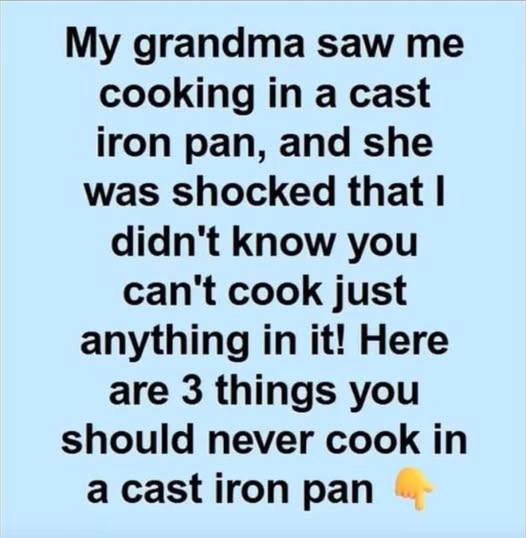
Cast iron skillets are beloved in kitchens around the world for their durability, heat retention, and ability to create incredible flavor. From sizzling steaks to golden cornbread, they can handle a lot. However, not every ingredient is suited for cast iron. Some foods can damage the pan, strip its seasoning, or absorb unpleasant metallic flavors. Here’s what you should avoid cooking in cast iron — and why.
1. Acidic Foods (Tomatoes, Vinegar-Based Sauces, Citrus)
Cooking acidic ingredients like tomato sauce, lemon-based dishes, or vinegar-heavy reductions in cast iron can break down the seasoning and leave your dish tasting metallic. If your skillet is very well-seasoned, the occasional use might be fine, but repeated cooking of acidic foods will harm the pan over time.
Why to avoid it: Acid reacts with iron, stripping the protective layer and potentially giving your food an unpleasant taste.
2. Sticky Foods (Delicate Fish, Eggs, Pancakes)
Cast iron may not be the best for delicate foods unless the seasoning is flawless. Thin fillets of fish or scrambled eggs tend to cling stubbornly to the surface, making cleanup difficult and leaving you frustrated.
Also Read : The 10 Things You Should Never Store on Your Kitchen Countertops — And Why Most People Still Do It
Why to avoid it: If your skillet isn’t perfectly seasoned, sticky foods will tear apart or leave behind residue, damaging the finish.
3. Smelly Foods (Garlic, Onions, Strong Fish)
One quirk of cast iron is that it can retain aromas. Cooking very pungent ingredients in your skillet can make those flavors linger, sometimes transferring into your next dish.
Why to avoid it: Cast iron’s porous surface absorbs odors, which can make sweet recipes like cornbread taste faintly of fish or garlic.
4. Slow-Simmered Liquids (Chili, Soups, Stews)
Though cast iron holds heat well, it isn’t ideal for dishes that require hours of simmering. Long exposure to moisture can gradually strip away seasoning, leaving you with a patchy or sticky pan.
Why to avoid it: Extended cooking with lots of liquid weakens the seasoning layer and makes the pan prone to rust.
5. Desserts with Delicate Flavors (Cakes, Pies, Custards)
While you can bake in cast iron, it may not be the best choice for light-flavored desserts. Any lingering flavors from previous savory meals can seep into your baked goods, leaving your cake with an odd aftertaste.
Why to avoid it: Residual flavors from savory dishes may ruin delicate or sweet recipes.
So, What Should You Cook in Cast Iron?
Cast iron shines when used for:
- Steaks and chops (perfect sear)
- Fried chicken
- Cornbread
- Roasted vegetables
- Potatoes
- Fajitas
These foods benefit from the skillet’s ability to get blazing hot and distribute heat evenly.
Final Thoughts
A cast iron skillet is one of the most versatile tools in the kitchen, but it’s not invincible. Avoid cooking acidic, sticky, overly aromatic, or long-simmered liquid dishes in it, and you’ll keep your skillet in great condition for decades. With proper care and seasoning, your cast iron can truly become a family heirloom.




